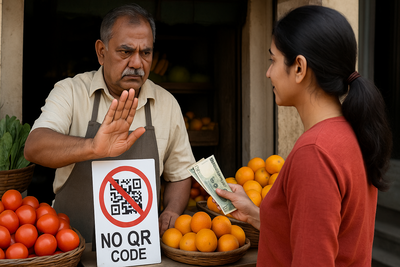Introduction
Karnataka’s recent GST crackdown is triggering unease among small traders—with over 14,000 receiving notices based on UPI transactions. As a result, QR code stickers are being removed, and digital payments are rejected in favor of cash. This emerging resistance highlights concerns around tax compliance, financial transparency, and the future of digital payments in India.
👉 In this feature, Manika TaxWise unpacks the story: What’s behind the crackdown, how traders are responding, the implications for stakeholders, and practical tips to stay compliant in this fast-changing tax landscape.
🧾 What’s Driving the Crackdown?
1. UPI Data Reveals Unregistered Trading
-
Authorities tapped into UPI data from 2021–22 to 2024–25 to flag traders exceeding ₹40 lakh annual turnover via QR codes without GST registration
-
Approximately 14,000 traders have received notices from Karnataka’s Commercial Tax Department
2. GST Thresholds & Penalties
-
Under GST law:
-
Goods: Mandatory registration over ₹40 lakh turnover.
-
Services: Threshold at ₹20 lakh.
-
-
Notices include arrears dating back to 2021–22, sometimes reaching ₹40–50 lakh—intimidating sums for small businesses
3. Purpose Behind the Push
-
Government aims to:
-
Widen tax base.
-
Curb unfair competition.
-
Bridge ₹1.2 lakh crore GST target, having collected ₹26,241 crore so far
-
🔻 Trader Response: QR Codes Vanish, Cash Returns
1. "No UPI – Only Cash"
-
Vendors in Bengaluru are putting up signs—some even removing QR stickers and scribbling “No UPI, only cash.”
2. Fear of Record Trails
-
Traders worry that UPI payments create digital footprints triggering tax inquiries
3. Social Feedback
“If u turn down UPI payments you lose 70% of your business on spot… Usually they will ready few more QRs of proxy accounts to distribute the funds.”
-
Consumers lamented the inconvenience: withdrawing cash for the first time in years .
📈 Impacts: For Traders, Consumers, and Digital Payments
| Stakeholder | Immediate Impact | Long-Term Outlook |
|---|---|---|
| Traders | Facing notices, fear of retrospective tax, burden of compliance costs | Pressure to register or risk cash black hole |
| Consumers | Return to cash; transaction inconvenience | Might shift to digital-friendly platforms or bigger stores |
| UPI/Digital Ecosystem | Hit to adoption momentum, short-term dip in volumes | Risk of stall unless policy clarifies |
-
Bengaluru accounts for 7.73% of India’s UPI transactions (May 2025), second only to Maharashtra
🛡️ Practical Tips for Traders
-
Check Compliance Status
-
Assess UPI income versus GST thresholds.
-
-
Register Promptly
-
Opt for Composition Scheme if turnovers are moderate.
-
-
File & Explain
-
Respond to notices—present records: personal transfers vs. business income.
-
-
Installments for Arrears
-
Authorities allow staggered payments under genuine cases
-
-
Use Digital Properly
-
Maintain separate accounts, issue bills for digital payments.
-
-
Consult Professionals
-
Accountants/chartered professionals can help evaluate notices.
-
🔍 Broader Takeaways
-
Govt Trend: Leveraging fintech data (especially UPI) to formalize informal trade .
-
Need for Balance: Fair enforcement vs. small trader vulnerability—a caution highlighted by experts
-
Benchmarking: Karnataka might pave the way for other states to follow suit and intensify digital-tied audits.
💡 What Traders & Consumers Should Do
For Traders:
-
Audit income sources.
-
Proper GST registration and invoicing.
-
Educate staff and public about digital payments and tax norms.
For Consumers:
-
Be prepared for cash preferences.
-
Support compliance by requesting bills.
-
Alert officials about unfair tax harassment, if credible.
For Digital Ecosystem:
-
Collaborate with trade bodies to clarify thresholds.
-
Offer awareness campaigns about formalization and GST compliance.
Conclusion
The Karnataka GST crackdown underscores how deeply digital payments are entangled with tax policy. For traders, the shift back to cash reflects fear—but clarity and compliance remain the best path forward. For consumers and fintech players, policy sensitivity and proactive engagement are key to sustaining India’s digital payment journey.
Manika TaxWise encourages all stakeholders to stay informed, embrace digital with compliance, and ensure the ecosystem remains fair, transparent, and progressive.
Frequently Asked Questions (FAQs)
Q1. Is removing UPI QR codes legally allowed?
Yes—but refusing UPI doesn’t exempt a trader from GST if turnover exceeds thresholds. It may raise suspicion.
Q2. What turnover triggers GST registration?
₹40 lakh for goods, ₹20 lakh for services. Composition Scheme is optional up to ₹1.5 crore.
Q3. Can traders contest notices?
Absolutely—respond with valid records and clarify exempt or personal transactions. Installment payments are possible
Q4. As a consumer, how do I support compliance?
Request bills for UPI payments and prefer businesses that maintain transparency.
Q5. Will digital payments decline long-term?
Short-term dip possible. But with better policy-ecosystem alignment, digital adoption is likely to rebound.
Keywords: Karnataka GST crackdown, UPI QR codes removal, GST notices Karnataka, small traders cash fallback, digital payment impact, GST compliance tips

